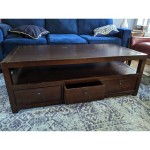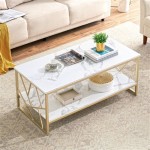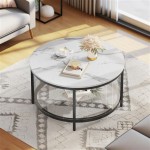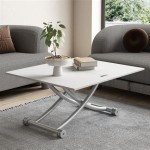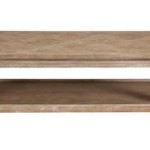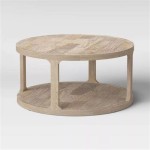The Allure and Practicality of 6-Foot Long Coffee Tables
Coffee tables, often positioned as the central anchor within a living room, offer more than just a place to rest beverages. They serve as focal points, contribute to the overall aesthetic, and provide essential functionality. Among the diverse range of sizes available, the 6-foot long coffee table presents a unique proposition, balancing expansive surface area with considerations for space and design.
This particular length offers significant advantages in certain living room configurations. It’s particularly well-suited for larger seating arrangements, such as long sofas or sectional couches, ensuring that everyone within the seating area has convenient access to the table. The generous surface area allows for the display of decorative items, books, and even board games, transforming the coffee table into a dynamic and engaging element of the room.
However, incorporating a 6-foot long coffee table requires careful consideration. The size demands adequate space to prevent the living room from feeling cramped. Factors such as the room's dimensions, the scale of other furniture pieces, and the desired flow of movement all play a crucial role in determining whether this length is a suitable choice.
Optimizing Space and Layout with a 6-Foot Coffee Table
Strategic planning is paramount when integrating a 6-foot coffee table into a living space. First and foremost, accurate measurements of the room are essential. The coffee table should be positioned approximately 12 to 18 inches away from the sofa to allow for comfortable legroom and ease of movement. Furthermore, the surrounding walkways should remain unobstructed to maintain a sense of openness.
In smaller living rooms, a 6-foot coffee table might overwhelm the space, making it feel crowded and hindering circulation. Consider the overall dimensions of the room and the existing furniture. If the room is narrow or contains multiple large pieces, a smaller coffee table might be a more practical choice. Conversely, in a spacious living room with a proportionally large sofa, a 6-foot coffee table can fill the visual void and create a more balanced and cohesive aesthetic.
Consider also the shape of the coffee table. While rectangular shapes are common and often complement long sofas, other shapes, such as oval or racetrack, can soften the lines of the room and improve traffic flow, especially in tighter spaces. The choice of shape should be dictated by the room's layout and the desired visual effect.
Beyond measurements and shape, vertical space is also a key consideration. Low-profile coffee tables can visually expand a room, while taller options provide more storage opportunities. Evaluate the existing furniture's height and select a coffee table that complements it without obstructing views or hindering interaction.
Materiality plays a significant role in the perception of space. Lighter materials, such as glass or light-colored wood, tend to make a room feel brighter and more open, while heavier materials, such as dark wood or metal, can ground the space and create a sense of solidity. The choice of material should be aligned with the overall design aesthetic and the desired atmosphere.
Material Choices and Design Aesthetics
The material composition of a 6-foot coffee table significantly impacts its aesthetic appeal and durability. A wide array of materials are available, each offering its own unique characteristics and visual qualities. Wood, metal, glass, and stone are among the most common choices, each presenting distinct advantages and disadvantages.
Wooden coffee tables, for example, offer warmth, versatility, and timeless appeal. Various wood types, such as oak, walnut, maple, and pine, provide a range of colors, grains, and textures to suit different design styles. Solid wood coffee tables are known for their durability and longevity, while veneer options offer a more affordable alternative with similar visual characteristics.
Metal coffee tables, on the other hand, exude a modern and industrial aesthetic. Stainless steel, wrought iron, and powder-coated metal are common choices, offering a range of finishes and textures. Metal coffee tables are typically highly durable and require minimal maintenance. They are also often paired with glass or wood tops for added visual interest and functionality.
Glass-topped coffee tables offer a sleek and contemporary look. Glass allows light to pass through, making the room feel brighter and more spacious. Tempered glass is a common choice for safety and durability. Glass tops can be combined with metal or wood frames for added structural support and aesthetic appeal.
Stone coffee tables, such as marble or granite, impart a sense of luxury and sophistication. Stone is highly durable and resistant to heat and scratches. However, stone coffee tables can be quite heavy and require careful handling. They are often used as statement pieces in formal living rooms.
Beyond the primary material, consider the finish and details. A glossy finish reflects light and creates a polished look, while a matte finish offers a more subtle and understated aesthetic. Decorative hardware, such as knobs, pulls, and legs, can add visual interest and complement the overall design style.
The choice of material and design should be congruent with the overall aesthetic of the living room. A rustic living room might benefit from a reclaimed wood coffee table, while a modern living room might be better suited for a glass-topped coffee table with a metal frame. Consider the existing furniture, color palette, and architectural details to ensure that the coffee table seamlessly integrates into the space.
Functionality and Storage Solutions
Beyond aesthetics, the functionality of a 6-foot coffee table is a crucial consideration. The generous surface area provides ample space for various activities, from serving refreshments to displaying decorative items. However, the table's functionality can be further enhanced by incorporating storage solutions.
Coffee tables with built-in drawers offer convenient storage for remote controls, magazines, and other small items. Drawers help to keep the tabletop clutter-free, creating a more organized and visually appealing space. The number and size of the drawers should be determined by the individual storage needs.
Shelves are another popular storage solution for coffee tables. Open shelves provide easy access to books, baskets, or decorative items. They also offer a visual break, preventing the coffee table from feeling too monolithic. The height and depth of the shelves should be sufficient to accommodate the intended items.
Lift-top coffee tables offer a unique and versatile storage solution. The tabletop can be lifted to create a higher surface for working or dining. The space beneath the tabletop can be used for storing blankets, pillows, or other bulky items. Lift-top coffee tables are particularly well-suited for small apartments where space is at a premium.
Consider the accessibility of the storage compartments. Drawers and shelves should be easy to open and close. Lift-top mechanisms should be smooth and reliable. The placement of the storage compartments should be convenient for the users.
In addition to built-in storage, consider using decorative boxes or baskets to organize small items on the tabletop or shelves. These containers add visual interest while keeping clutter at bay. Choose boxes and baskets that complement the overall design style of the living room.
The height of the coffee table is also an important factor in its functionality. A coffee table that is too low can be difficult to reach, while a coffee table that is too high can obstruct views. The ideal height should be slightly lower than the seat cushions of the sofa.
The surface of the coffee table should be durable and easy to clean. Consider materials that are resistant to scratches, stains, and heat. Regularly wipe down the surface to remove spills and dust. Using coasters and placemats can help to protect the surface from damage.
Ultimately, the ideal functionality and storage solutions depend on individual needs and preferences. Carefully consider how the coffee table will be used and choose features that will enhance its practicality and convenience.

Long Rectangular Lane Acclaim Coffee Table Vintage Midcentury Occasional Tables Sweet Modern Akron Oh

Solid Wood Rectangle Coffee Tables Handcrafted What We Make

Oak Coffee Table With Slide Top Ez Mountain Rustic Furniture

Large Natural Wood Low Rectangular Coffee Table Cms Furniture Boutique

Buy Dark Chester Marble Mango Wood Round Coffee Table From The Next
Very Home Ashwin Small Coffee Table Contains Solid Wood

Buy Dark Marble Pebble Soild Mango Wood Coffee Table From The Next

Wooden Rustic French Style Large Coffee Table With Drawer

Abby 47 1 4 W Walnut Veneer Wood Rectangular Coffee Table 032d7 Lamps Plus

Cosmo Coffee Table By Tonin Casa Room Service 360

